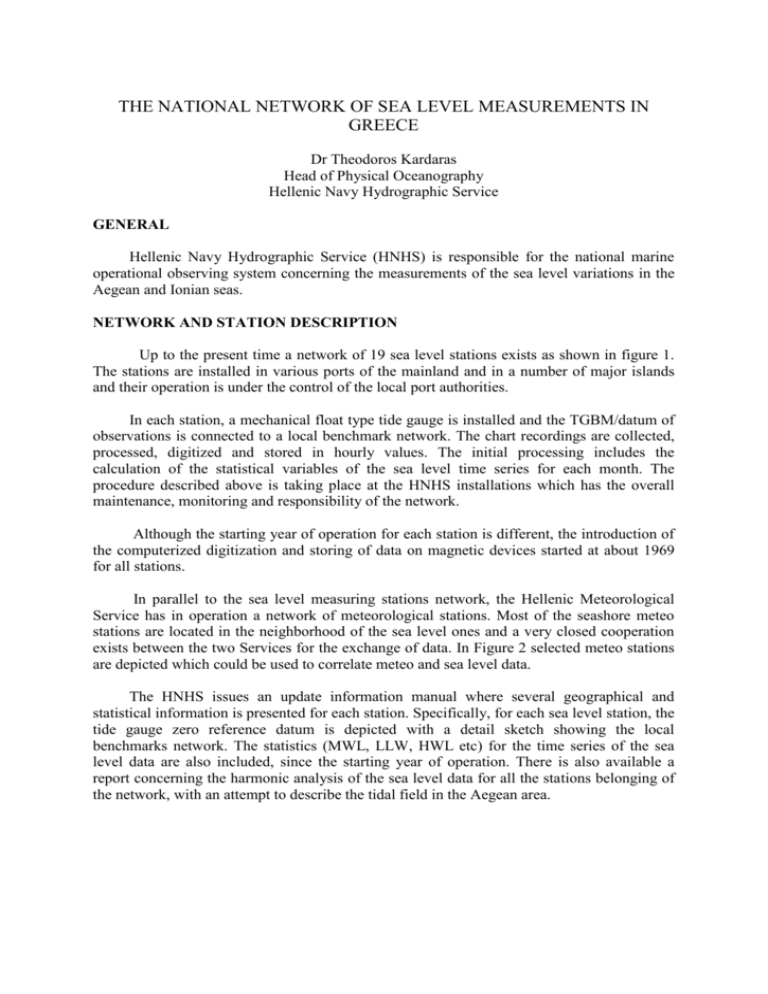2001 - Permanent Service for Mean Sea Level
advertisement

THE NATIONAL NETWORK OF SEA LEVEL MEASUREMENTS IN GREECE Dr Theodoros Kardaras Head of Physical Oceanography Hellenic Navy Hydrographic Service GENERAL Hellenic Navy Hydrographic Service (HNHS) is responsible for the national marine operational observing system concerning the measurements of the sea level variations in the Aegean and Ionian seas. NETWORK AND STATION DESCRIPTION Up to the present time a network of 19 sea level stations exists as shown in figure 1. The stations are installed in various ports of the mainland and in a number of major islands and their operation is under the control of the local port authorities. In each station, a mechanical float type tide gauge is installed and the TGBM/datum of observations is connected to a local benchmark network. The chart recordings are collected, processed, digitized and stored in hourly values. The initial processing includes the calculation of the statistical variables of the sea level time series for each month. The procedure described above is taking place at the HNHS installations which has the overall maintenance, monitoring and responsibility of the network. Although the starting year of operation for each station is different, the introduction of the computerized digitization and storing of data on magnetic devices started at about 1969 for all stations. In parallel to the sea level measuring stations network, the Hellenic Meteorological Service has in operation a network of meteorological stations. Most of the seashore meteo stations are located in the neighborhood of the sea level ones and a very closed cooperation exists between the two Services for the exchange of data. In Figure 2 selected meteo stations are depicted which could be used to correlate meteo and sea level data. The HNHS issues an update information manual where several geographical and statistical information is presented for each station. Specifically, for each sea level station, the tide gauge zero reference datum is depicted with a detail sketch showing the local benchmarks network. The statistics (MWL, LLW, HWL etc) for the time series of the sea level data are also included, since the starting year of operation. There is also available a report concerning the harmonic analysis of the sea level data for all the stations belonging of the network, with an attempt to describe the tidal field in the Aegean area. DATA EXPLOITATION Based on the processed sea level data, a great number of scientific presentations and publications have been produced and a number of EEC and national funded research projects made use of them. The following is an indicative list: 1.VARIAGIN M.A.,1974. Contribution to the analysis and prediction of Hellenic ports tides. Oceanographic study no 9, Hellenic Navy Hydrographic Service (In Greek). 2.KARDARAS T and A. ZOI-MOROY , 1987. Low frequency sea level fluctuations in the Aegean Sea. Procedures of the 2nd Panellenic Symposium of Oceanography and Fisheries, Athens, 1987, pp 174-179 (In Greek) 3.LASCARATOS A. and M. GACIC, 1990. Low frequency sea level variability in the Northeastern Mediterranean, J.P.O., Vol 20, No 4, 522-533. 4.NITTIS K., 1993. A study of the Aegean and Ionian seas variability in the synoptic and seasonal scale. PhD dissertation, University of Athens, 1993. 5.TSIPLIS M. and G. VLACHAKIS, 1994. Meteorological forcing and sea level variability in the Aegean Sea. Journal of Geophysical Research, V.99,No C5, pp 9879-9890. THE FUTURE 1. The upgrading of the network is one of the primary objectives of the HNHS. A first step is to evaluate the cost/ effectiveness of the network automation by installing a near real time transmission of the data from the various stations. The procedure has been already started by fixing the appropriate equipment to a specific station (there are plans for two more stations) , which converts the analog plot to digital format data and provides the means for data storing and transferring to a remote computer. The outcome is going to assist with the further steps of development. 2. A joint proposal between HNHS and the Institute of Marine Biology at Crete was submitted to the 3rd Framework Program of the European Union. The proposal aims to establish two climatic sea level stations at Rafina (East to Athens) and at Plomari (Lesvos island, Eastern Aegean). Each station will be consisted of a bubble pressure sea level sensor, a number of meteo sensors and a GPS receiver. Data collected will be transmitted in near real time to the HNHS installations for further analysis and dissemination. 3. A joint project between HNHS and the Technical University of Crete is underway in order to install a complete new sea level measurement station at GAVDOS island, south of Crete. The upgrading of the existing sea level station at Souda area is also included in the project. The proposed station will be equipped with state of the art tide gauge sensor, a GPS receiver, transponder and meteo sensors. The project aims to provide satellite altimetry calibration. 42.0 Kavala Alexandroupolis Thessaloniki 40.0 Skopelos Preveza Lefkada Evoikos Chios Patra Salamina Poseidonia Pireas 38.0 Katakolo Syros Leros Kalamat a Rodos 36.0 Chania Heraklio 34.0 20.0 22.0 24.0 26.0 28.0 Figure 1. Map showing the sea level stations 42.0 Kavala Alexandroupolis Thessaloniki 40.0 Limnos Kerkira Anhialos Aktio Skiros Chios 38.0 Elliniko Araxos Kalamata Naxos Rodos 36.0 Chania Heraklio 34.0 20.0 22.0 24.0 26.0 Figure 2. Map showing the selected meteo stations 28.0








